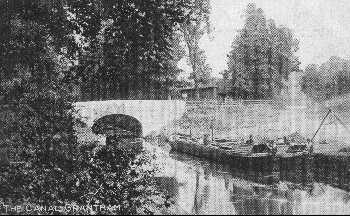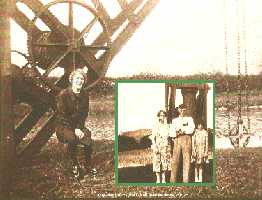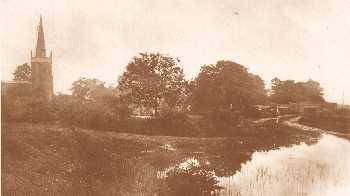A journey along the Grantham canal 1881

A journey along the Grantham canal 1881 |
 |
Grantham was crowded. Showmen from all over the country and continent had converged on the town for the Mid-Lent fair to be held on the following Monday, Tuesday and Wednesday. Their caravans filled the Market Place and the surrounding streets. Besides the showmen with mechanical exhibitions there were photographers, conjurers, shooting galleries, wax work exhibitions and marionettes. The Inns were packed to capacity and a troop of musicians from Germany were lodging in Welby Street.
I was pleased to be away from all the hustle and bustle promised for the following three days. Having been offered employment in Nottingham I chose to take a few days and walk the distance alongside the Grantham canal.
Wharf Road leads to the canal terminus. I paused at number 31 to seek advice from Mrs Mary Robinson, born at Barkston in the Vale and formerly a boatman's wife, her knowledge would be invaluable for my trip. Just time for a farewell drink in the last "Blue" public house, the aptly named Blue Boat . The widowed Mary Milner is now head publican, but needs to takes in lodgers to keep the Blue Boat afloat.
There are three occupied cottages on the wharf; Mr Cotterell, agent to the Great Northern Railway and Thomas Musson a horse shunter on the railway. But of interest to me was Mr Caleb Page, canal inspector. I lingered to pass a few words and learnt some useful contacts for the journey ahead. I don't recall if there were any day boats at the wharf, but there were no living boats, the area was quiet compared to the frenzy in the town.
Picture right: Harlaxton Wharf with two narrow boats, William and Hanna
At Woolsthorpe the first lock is found, but the second is of more interest, having a house alongside and an arched bridge at the tail. I spoke to a woman in the cottage garden. She said her name was Elizabeth Willis and her husband was a carpenter but was away from home. While her seven children played around the lock she spoke of their move from Grantham some four years ago. The children clearly enjoyed the freedom of the countryside and I could imagine the family remaining in this idyllic spot for many years.
Mrs Willis introduced me to her neighbour James Pacey a brickmaker who invited me to join him for a drink at the beer house kept by Benjamin Wright, here we met George Pearson, he lodged on the premises, with his wife and three children. Mr Pearson owned a barge and was the local coal dealer. He was making a trip towards Nottingham the next day and offered me free passage, so as the day was closing I accepted the offer of a meal and bed at Woolsthorpe Wharf.
Picture right: The crane at Muston Wharf in the 1920's. As we passed Bottesford Wharf, Mr Pearson spoke to Thomas Roberts who called himself a Wharfinger, but at 78 he wasn't up to much and neither was Thomas his son. At 25 'wharfingers son' was hardly an occupation at Bottesford Wharf, quiet now, since the railway was far more convenient for the town.
We were soon at Redmile and still moored on the wharf were two living boats. No families on these coal boats, only the bargemen Henry Manderfield and Frank Newman with their mates, William Minkley and George Riley. They all looked a bit bleary eyed, perhaps for staying too long at the Old Wind Mill where William Harrison is the Licensed Victualer and butcher. As if that was insufficient they admitted to joining John Clower at the Peacock Inn for a nightcap. Picture left: The canal at Redmile, looking west towards the bridge
I left the boat here and continued my journey on foot. Peter Day was busy trimming the towpath hedge along the embankment. Born and bred in Redmile he worked as canal labourer on the navigation to keep his wife and four children at their Redmile cottage.
As I passed mill bridge I could see the turning sails of Richard Musson's
post mill
on the hill to my left. Folks in Redmile said he was a fortune hunter, having married the millers widow ten years his senior. But he had her sons to contend with, both working alongside him and no doubt eager to take over the business which they considered rightfully theirs.
To my right the new works of the
Great Northern and London and North Western Railway
still scarred the countryside. But the imposing station for the Duke of Rutland was well staffed with Mr Copley having moved from Bradford to take the station masters post. At 35 he could move on again if he made a success of this minor prestigious position. He was assisted in the running of the station by two signalmen. John Wilkinson had moved from Staffordshire and John Waller from Boston. With porter George Robinson they worked long hours serving
train departures
from 8am to 9.30 in the evening.
Pausing at Barkestone Wharf I advised Mrs Turner that the coal barge was on it's way. She replied that wood was their fuel at present as her husband John a master builder, had been laid off due to the recent bad weather. I pressed on to my intended destination for the night, Cropwell Bishop. Picture right: Cropwell Wharf - alongside the Fosse Way
The canal was peaceful as I passed the skin works and into the countryside. Harlaxton wharf in the cutting was deserted, piles of coal having been unloaded awaited delivery to local houses by William Towers the coal merchant. Even the fishermen had abandoned the bank in exchange for festivities in Grantham.
Taken before 1911
It was an early start from Woolsthorpe Wharf. Mr Pearson had a motive in his invitation as he expected me to work the wide locks at the start of our trip. The boat passed Muston Wharf where the crane and tramway awaited the next boat with goods for Belvoir castle. Occupants of Muston Gorse Farm and the canal side cottage were busy with their early morning chores, while eight year old Fred Green could be seen making his way across the field to school at Redmile.
Insert shows the former hump bridge in the background.
With thanks to Sheila Marriott for use of these family pictures.

The buildings now long since demolished.